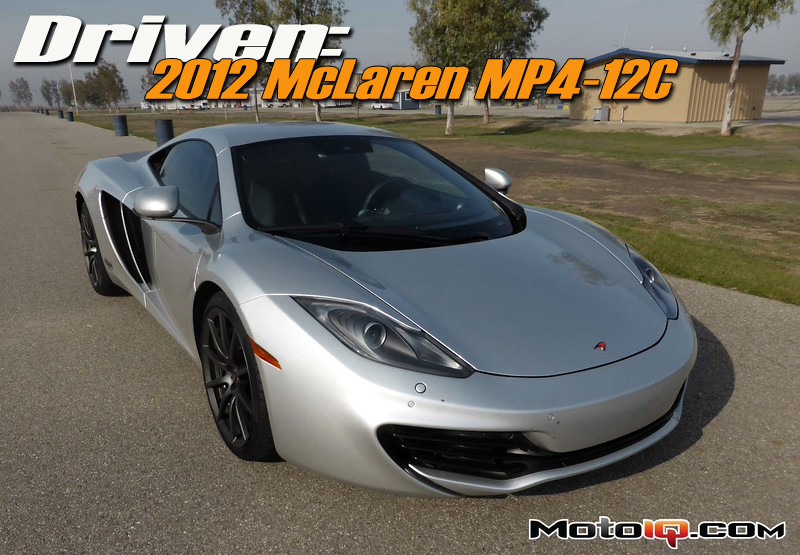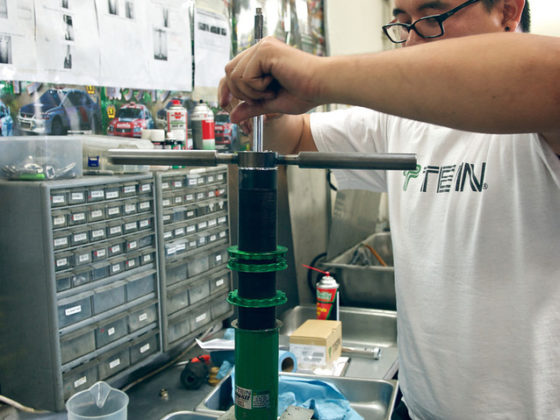 Through Star Mazda, the 12C pulled 1.0 G’s on average with a 56.6mph minimum cornering speed.
Through Star Mazda, the 12C pulled 1.0 G’s on average with a 56.6mph minimum cornering speed.
I’ve heard stories of how scary and uncontrollable the 12C is without TCS, so I was eager to see how the car changed now that I had the systems turned off. Once back out on track, there was not a huge difference. The 12C’s balance remained a stable understeer on throttle for medium and higher speed corners, it put the power down very well with similar on-throttle understeer but most importantly, it still entered corners like a champion. Now with the TCS turned off, the car will respond with the rotation and oversteer that everyone wants. I was very pleased that I could accelerate aggressively over rises and crests in the road and this greatly helped the lap time at Buttonwillow.
Exiting the Turn-2 hairpin at 40mph, I booted the throttle and as you should expect from a 500whp+ rear-wheel-drive car, the rear end kicked out sideways. I was surprised with how the 12C reacted since the McLaren engineers opted for an open differential to save weight and simplify the car by using the inside rear brakes to actively prevent excessive inside wheel spin. They essentially created torque-vectoring which allows the car to seemingly defy physics (like a Nissan GTR) which allows for on-throttle oversteer more comparable (and potentially better) than a car with a Limited Slip Differential. McLaren did such a good job with this programming that you wouldn’t even know the 12C does not have an LSD. This solution does makes me wonder how much added abuse the rear pads and rotors will see since typically cars go through front brakes much quicker than rears.
 Our showroom stock McLaren MP4-12C posted a time of 1:50.180 on its factory Pirelli PZero Corsa tires. The fastest production car lap time that we are aware of.
Our showroom stock McLaren MP4-12C posted a time of 1:50.180 on its factory Pirelli PZero Corsa tires. The fastest production car lap time that we are aware of.With TCS turned off, the 12C’s eager entry-rotation can be used effectively and provoked with throttle into nice and fun powerslides. While drifting is not the fastest way around the corner, it’s an important ability which the 12C was unable to execute when it was first launched. The original 2012 programming was apparently horrendous and would send even the most experienced driver spinning out of control when trying to balance the car at the limit or attempting to drift it. Thankfully McLaren realized the importance of this fun factor and the most recent 2014 program makes the 12C handle very well with more predictable characteristics beyond the limit, but there is still room for improvement here when compared to the 458.
I would hardly call the 12C uncontrollable with TCS turned off. In fact, it’s quite fun. Throttle response does lag slightly compared to a naturally aspirated car but not to the point that it affects how the car takes a corner. If it does, you’re most likely in the wrong gear. The overall balance of the 12C has a noticeable separation between understeer and oversteer. While you can provoke oversteer and maybe roasting the rear tires a little would help to neutralize the car, during the laps that I drove the 12C I would want the balance to be a little more neutral than swinging from under to oversteer. With a little more front aero and slightly less on throttle understeer (or again, a few more laps to burn up the rear tires) the 12C will feel better from a balance standpoint and be even faster on the stop watch.
Overall, the 12C’s computer controlled torque vectoring “Brake Steer” and a swaybar-less cross linked hydraulic suspension systems feel independent and noticeable which make for a very digital and unnatural driving dynamics. McLaren has to play catch-up to Ferrari in making these systems unperceivable and feel more integrated and natural to drive like the 458’s E-diff and magnetorheological dampers, which Ferrari has been fine tuning for a lot longer. Maybe the fact that the 12C has 34 separate ECUs while the Ferrari has their own electronic control systems developed by their subsidiary Magneti Marelli has something to do with each company’s ability to integrate these systems.
The 458 evokes more emotion with a predictable and confidence-inspiring chassis that feels second nature to drive, while the 12C is a torque monster and more challenging to master at the very limit, which I find entertaining. The 12C is faster on paper with greater straight line performance, a higher top speed (207mph vs. the 458’s 199mph), brakes better, and has more downforce. Both cars are close in lap time but if you drive the 12C the way the active systems are programmed, I think it will edge out the 458.
Due to these shortcomings, the 12C has a lot more potential than the 458, which is one of the best driving and pure sports cars on the road today. McLaren has already made huge leaps with a programming update for the 12C, I’m sure if or when they came out with another one they will close the gap to Ferrari in terms of driving feeling as well as further improving the car’s on track performance. To address the aerodynamic issue in the 12C, an aero kit is currently being built by Namimoto and tested by the fastest Time Attack team in the country: FX Motorsports Development.
 We were really impressed with the McLaren 12C on track at Buttonwillow. While I wouldn’t call it 100% refined or complete from a suspension integration standpoint, it is already similar if not faster around a track than the Ferrari 458 and with a few minor improvements, can be significantly faster.
We were really impressed with the McLaren 12C on track at Buttonwillow. While I wouldn’t call it 100% refined or complete from a suspension integration standpoint, it is already similar if not faster around a track than the Ferrari 458 and with a few minor improvements, can be significantly faster.Is the 12C a modern-day NSX? Since the NSX 2.0 is due to be released in 2015 and seems to have a different mission than the original did in the early 90’s, I would say the McLaren MP4-12C most certainly is. Other than getting out of it, the 12C is probably a better daily driver than its competition due to its superior ride which is both comfortable and easy to drive under the limit. Its world-class handling begs the question whether to respect or resent it for having so much technology that makes it this easy to drive. You could literally drive this car every day to run errands or simply enjoy the pleasure of driving, and it can be as docile as a family sedan while getting excellent gas mileage. But the 12C’s Jekyll and Hyde personality wakes up with TCS off to become an exciting, challenging monster on track that can take down a Ferrari. It truly is a fantastic engineering work of art; and with some minor improvements, can be significantly better.
Is the McLaren 12C the fastest production car around Buttonwillow? At the time of this writing, this author does not know of any other stock production car that has posted a faster lap than the 12C’s 1:50.180 lap time.
SOURCES:
Namimoto
Check out additional car reviews by the author:
MotoIQ: 2015 Mustang GT Review
MotoIQ: 2015 Mustang ECOBOOST Review
.



